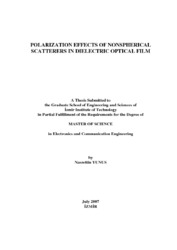Please use this identifier to cite or link to this item:
https://hdl.handle.net/11147/3324Full metadata record
| DC Field | Value | Language |
|---|---|---|
| dc.contributor.advisor | Dinleyici, Mehmet Salih | en |
| dc.contributor.author | Yunus, Nasrettin | - |
| dc.date.accessioned | 2014-07-22T13:51:20Z | - |
| dc.date.available | 2014-07-22T13:51:20Z | - |
| dc.date.issued | 2007 | en |
| dc.identifier.uri | http://hdl.handle.net/11147/3324 | - |
| dc.description | Thesis (Master)--Izmir Institute of Technology, Electronics and Communication Engineering, Izmir, 2007 | en |
| dc.description | Includes bibliographical references (leaves: 79-80) | en |
| dc.description | Text in English; Abstract: Turkish and English | en |
| dc.description | xi, 82 leaves | en |
| dc.description.abstract | Polarization enhancement in liquid crystal display (LCD) backlighting systems comprises important part of works on improvement of the brightness. Optical films containing scatterer particles are used in these systems. Therefore, dielectric scatterer particles are greatly needed to be analyzed for their optical scattering properties, and especially for polarizing effects. Depending on the sizes relative to the wavelength and the shape of the particles various computation approaches have been developed based on electromagnetic scattering theories such as Mie scattering, T-matrix methods etc... Simulation programs of these approaches have been examined and applied for spherical and nonspherical particles. In general, for the particles those a few times large in size compared to the incident wavelength, the polarization differentiation is insignificant for a spherical particle compared to a spheroid one. And, the prolate spheroids with higher aspect ratio have been able to produce most significant differentiating figures. Polarization measurements have been carried on commercially available dielectric optical films of two different set and also on the films with/without nonspherical zeolite particles prepared in the laboratory. Since the commercial films consist of spherical scatters, they show no polarization discrimination at all. On the other hand existence of zeolite particles in the film resulted in significant polarization discrimination at forward scattering angle. The results for polarization discrimination properties of the prolate spheroid particles have been compared with the spherical ones. Consequently, the discrepancy induced on the polarization that way has a good potential to be used in improvement of the brightness. | en |
| dc.language.iso | en | en_US |
| dc.publisher | Izmir Institute of Technology | en |
| dc.rights | info:eu-repo/semantics/openAccess | en_US |
| dc.subject.lcc | TK7871.15.F5 Y95 2007 | en |
| dc.subject.lcsh | Polarization (Light) | en |
| dc.subject.lcsh | Dielectric films | en |
| dc.subject.lcsh | Optics | en |
| dc.title | Polarization effects of nonspherical scatterers in dielectric optical film | en_US |
| dc.type | Master Thesis | en_US |
| dc.institutionauthor | Yunus, Nasrettin | - |
| dc.department | Thesis (Master)--İzmir Institute of Technology, Electrical and Electronics Engineering | en_US |
| dc.relation.publicationcategory | Tez | en_US |
| item.languageiso639-1 | en | - |
| item.fulltext | With Fulltext | - |
| item.openairecristype | http://purl.org/coar/resource_type/c_18cf | - |
| item.openairetype | Master Thesis | - |
| item.grantfulltext | open | - |
| item.cerifentitytype | Publications | - |
| Appears in Collections: | Master Degree / Yüksek Lisans Tezleri | |
Files in This Item:
| File | Description | Size | Format | |
|---|---|---|---|---|
| T000640.pdf | MasterThesis | 1.63 MB | Adobe PDF |  View/Open |
CORE Recommender
Page view(s)
86
checked on Jul 22, 2024
Download(s)
36
checked on Jul 22, 2024
Google ScholarTM
Check
Items in GCRIS Repository are protected by copyright, with all rights reserved, unless otherwise indicated.